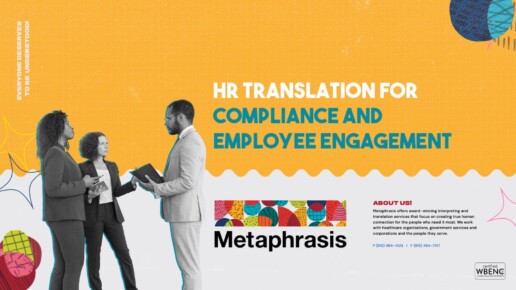HR Translation for Compliance and Employee Engagement
In today’s globalized workforce, effective communication plays a pivotal role in fostering employee engagement, maintaining legal compliance, and ensuring that all employees—regardless of their language—can access essential HR resources. HR translation services have become an indispensable tool for organizations seeking to overcome language barriers. These services are not just about translating words; they’re about preserving meaning, tone, and accuracy while respecting cultural nuances. This blog explores why HR translation services matter, the documents that need translation, and how they can contribute to workplace harmony.
Why Provide HR Translations?
HR translations offer more than just linguistic convenience; they help build trust, improve engagement, and reduce compliance risks. Let’s break down the core reasons why organizations should invest in HR translation services:
Legal Compliance
Many countries require that companies provide critical HR documents, such as employment contracts, safety guidelines, and workplace policies, in a language employees understand. Failing to comply with these regulations can lead to costly penalties, lawsuits, and reputational damage. By translating HR materials, organizations can meet legal requirements while ensuring that all employees are on the same page.
Employee Engagement and Inclusion
Imagine starting a new job where the employee handbook, benefits details, or performance expectations are in a language you don’t fully understand. It would be stressful, right? HR translation bridges this gap, making employees feel included, valued, and well-informed. When people understand workplace policies, they’re more likely to be engaged and productive.
Reducing Miscommunication and Risk
Poor communication can lead to misunderstandings, decreased productivity, and even workplace accidents. For instance, safety instructions or compliance training materials that aren’t translated correctly could put employees at risk. Providing clear, accurate translations minimizes these risks and promotes a safe work environment.
Strengthening Workplace Culture
A workplace that embraces language diversity promotes a sense of belonging. When employees see that their organization is committed to accommodating different languages and cultures, it enhances loyalty and morale.
The Importance of HR Interpretation Services
While translations are crucial for written documents, interpretation services play a key role in real-time communication. Whether it’s during onboarding, training sessions, disciplinary meetings, or performance reviews, HR interpreters help facilitate effective two-way communication. This is especially critical in high-stakes conversations where misunderstandings could have serious consequences.
For example, during a workplace investigation or dispute resolution, having an interpreter ensures that everyone involved fully understands what’s being said. This not only reduces the risk of miscommunication but also demonstrates the organization’s commitment to fairness and transparency.
Important Documents to Have HR Translations in Place
To fully support a multilingual workforce, certain HR documents should always be translated. Below is a list of key documents that benefit from HR translations:
Employee Handbooks and Company Policies
Employee handbooks typically outline the company’s mission, values, rules, and expectations. Translating this document helps employees understand their roles, workplace behavior expectations, and available resources.
Employment Contracts
An employment contract is a legally binding agreement between the employer and employee. Translating these contracts reduces the risk of misunderstandings regarding job terms, compensation, benefits, and termination clauses.
Benefits and Compensation Information
Healthcare plans, retirement benefits, leave policies, and other compensation details should be clearly communicated to all employees. Translating these materials ensures that workers can make informed decisions about their benefits.
Safety Guidelines and Compliance Training Materials
Workplace safety is non-negotiable. Employers must ensure that all workers—regardless of their language—can understand safety protocols, emergency procedures, and compliance training. Proper translation in this area can literally save lives.
Disciplinary and Performance Review Documents
If an employee is being disciplined or undergoing a performance review, it’s essential that they fully understand what’s being discussed. Translating these documents ensures clarity and fairness in the process.
Onboarding Materials
Onboarding is the first step in an employee’s journey with the company. Translating onboarding materials, such as welcome kits, orientation guides, and training manuals, helps new hires feel supported and set up for success.
Exit Documents
When an employee leaves the company, providing translated exit interview forms, final paycheck details, and termination agreements can prevent confusion and legal disputes.
Be Prepared with Translation Services: Partnering with the Right Provider
To effectively manage HR translations, it’s important to partner with a reputable translation service provider. Here are some tips for selecting the right partner:
Look for Industry Expertise
Not all translation providers are created equal. Choose a service that specializes in HR translations and understands the unique challenges of workplace communication.
Prioritize Accuracy and Cultural Sensitivity
Accurate translations aren’t just about converting words; they require a deep understanding of cultural context. A good translation provider will ensure that the tone, style, and meaning of your documents are preserved.
Ensure Data Security
HR documents often contain sensitive information, such as employee personal data, salaries, and disciplinary records. Make sure your translation provider follows strict data security protocols to protect this information.
Consider Interpretation Services
If your workforce includes non-English speakers, consider offering interpretation services for important meetings, training sessions, and performance reviews. This will further enhance communication and inclusivity.
Evaluate Technology Solutions
Some translation providers offer technology-based solutions, such as translation management systems or AI-powered translation tools, to streamline the process and reduce costs. However, human translators are still essential for ensuring quality, especially for nuanced or sensitive content.
The Bottom Line: Building a Better Workplace with HR Translations
HR translation services are a powerful tool for promoting compliance, reducing risk, and creating a more inclusive workplace. By providing translated documents and interpretation services, organizations can bridge language gaps, improve employee engagement, and foster a culture of respect and understanding.
Investing in professional HR translations isn’t just a legal requirement; it’s a smart business strategy that benefits employees and employers alike. So, if your organization hasn’t yet prioritized HR translations, now is the time to take action.

